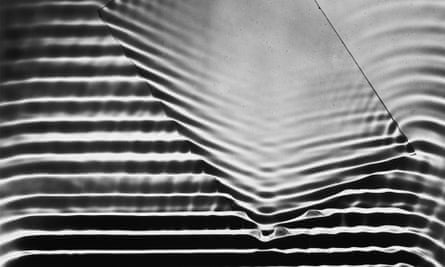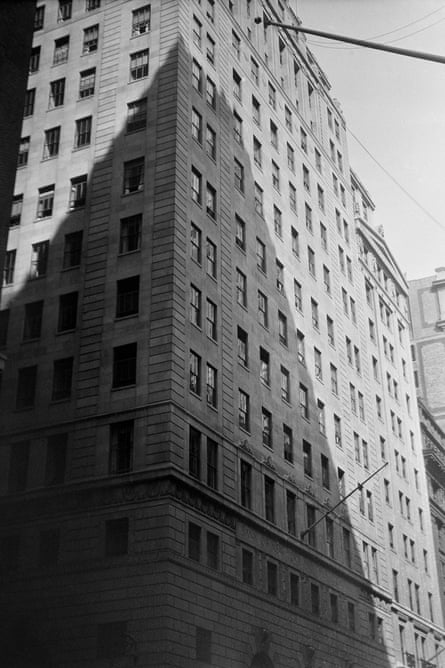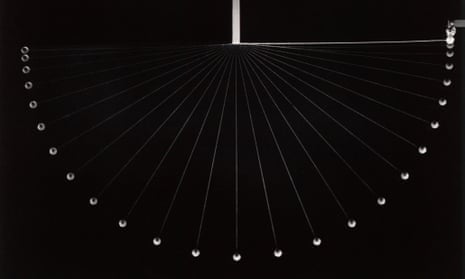In April 1939, Berenice Abbott wrote a “manifesto” entitled Photography and Science. “We live in a world made by science,” she stated. “There needs to be a friendly interpreter between science and the layman. I believe photography can be this spokesman, as no other form of expression can be.”
Though Abbott is known primarily as a modernist photographer for her black and white images of New York skyscrapers in the 1930s, it is her often formally beautiful science photographs, made between 1939 and 1960, that have been receiving academic and critical reappraisal of late. In 2012, Steidl published an exhaustive monograph, Berenice Abbott: Documenting Science, to accompany the exhibition of the same name at the Massachusetts Institute of Technology (MIT) Museum.
In a few weeks, a selection of her science photographs – including a wave pattern hitting a glass plate and the fixed centre of mass of a swinging wrench – will be among the many highlights of Revelations: Experiments in Photography, an intriguing exhibition at the Science Museum in London that traces science photography from the late 19th century to the present day.

“We are looking at the way early pioneers expanded the vision of the medium through x-rays and micro-photography,” says Ben Burbridge, co-curator, “and the ways these techniques and aesthetics have informed photography ever since, from modernists like Man Ray and Moholy-Nagy to what you might call the post-postmodernism of contemporary photographers like Trevor Paglen, Clare Strand and Ori Gersht, who engage with science and technology in an often more playful, self-questioning way. Abbott’s images stand out because they are primarily scientific illustrations but also function as fine art.”
Much of the early work in Revelations is by pioneers such as Henry Fox Talbot and Arthur Clive Banfield – who famously photographed “the life history of a splash”. They highlight what co-curator Greg Hobson describes as “photography’s ability to give form to the intangible”. By 1925, avant-garde artists had also realised photography’s singular potential to create new and often abstract images. Moholy-Nagy, a leading figure in the Bauhaus movement, had posited “the New Vision”, in which photography could become art though its unique way of seeing a world invisible to the human eye. His use of photograms, photomontage and multiple exposures to create abstract images remain influential to this day.
Revealingly, though, Revelations shows Abbott’s work alongside that of Man Ray, her first mentor and the artist who almost singlehandedly gave legitimacy to photography as a surrealist medium. In 1918, at the age of 19, she had left her native Ohio for New York’s Greenwich Village, where she was adopted by a bohemian demi-monde that included the novelist Djuna Barnes and the exiled Czech anarchist Hippolyte Havel. “He sort of sheltered me,” she said later. Two years later, Abbott travelled to Europe to study sculpture in Berlin and Paris, settling in the French capital and immersing herself in its burgeoning avant-garde scene. “We were completely liberated,” she said. “We had the illusion that we could go ahead and do our work and nothing would ever come along and stop us.”
A stylish, confident and beautiful young woman whose looks and androgynous style were in tune with the times, Abbott took up photography by accident, encouraged by Man Ray. She posed for him in 1921 and, soon after, became his assistant. Impressed by her instinctive ability, he allowed her to use his darkroom to develop her own work. Initially funded by Peggy Guggenheim, the American socialite and art-lover, she found her own studio, where her sitters included Jean Cocteau, André Gide and James Joyce alongside his wife Nora, his daughter Lucia, and his publisher Sylvia Beach. Many of Abbott’s early portraits were first shown on the walls of Beach’s famous Paris bookstore, Shakespeare and Company. “To be ‘done’ by Man Ray and Berenice Abbott meant you were rated as somebody,” Beach wrote in her memoir.

From the beginning, Abbott was a formally ambitious photographer. Her use of stark settings, moody lighting and eye-level framing created a series of memorable portraits in which the subject’s presence is all. Soon, though, she had abandoned portraiture for images in which people were palpable only by their absence. On a trip back to New York in 1929, she was taken by the energy and momentum of the city. Returning there soon afterwards, she roamed the streets with a hand-held camera, recording shop fronts, street scenes and working people, perhaps influenced by the great Eugène Atget, whom she had met shortly before his death and whose reputation she worked tirelessly to ensure.
In 1932, her aesthetic shifted and, using a large-format camera, she began photographing the architecture of the city in greater detail, often from dramatic points of view. She famously shot the Flatiron Building from below and Manhattan at night from above – perched on top of the Empire State Building. A now iconic book, Changing New York, appeared in 1939. By then, as her “manifesto” shows, she had the world of science in her sights.
“Her foresight is extraordinary,” says Burbridge, “given that she conceived her science photography project in 1939 and it was not really brought to fruition through proper funding until late 1958, when the Russian Sputnik was launched and American investment in science suddenly became intense.”

Initially, Abbott sought out commercial assignments for companies such as Standard Oil and IBM. Simultaneously, she was experimenting with ways to photograph magnetism and electricity and, in her attic, inventing various photography machines, including a “Super Sight” camera that allowed her to enlarge an object’s projection before exposure rather than on a negative in the darkroom. In all this, she was self-taught and utterly meticulous, planning exposures to the second and employing stroboscopic lights to trace the trajectory of bouncing or swinging metal balls.
Describing one of her wave pattern images, she said: “My idea was to do a Rayogram in motion. Moholy-Nagy and Man Ray had done pictures by putting objects on sensitized paper but I wanted to do the same thing in motion.” To this end, she placed a piece of light sensitive paper in the bottom of a developing tray and, as she put it “flashed the light”. The developed picture is both formally beautiful and mysterious. l
In 1944, she became the photographic editor of Science Illustrated and, in September of that year, made one of her most striking scientific photographs, a stark, almost modernist, delineation of the molecular structure of soap bubbles. Her breakthrough finally came in 1958, when she went for a job interview at the physical science study committee at MIT conducted by Dr Elbert P Little. “I told him that scientists were the worst photographers in the world,” she said. “They need the best – and I was the one.” A small selection of her ensuing photographs were subsequently published in 1960 in a groundbreaking American educational book called Physics, which was studied by millions of high school pupils.
Abbott died in 1991, aged 93. “I am so fascinated with this century,” she once said, “it will help keep me alive. I’ll be there until the last minute, fighting.”

Comments (…)
Sign in or create your Guardian account to join the discussion